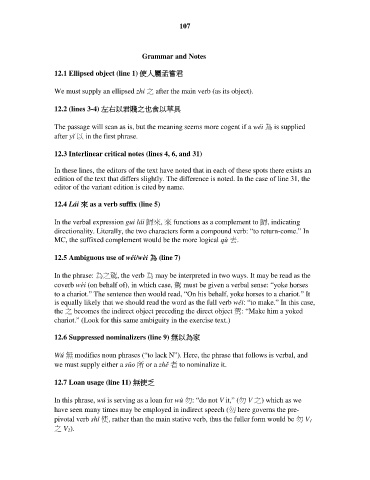Page 115 - EALC C306/505
P. 115
107
Grammar and Notes
12.1 Ellipsed object (line 1) 使人屬孟嘗君
We must supply an ellipsed zhi 之 after the main verb (as its object).
12.2 (lines 3-4) 左右以君賤之也食以草具
The passage will scan as is, but the meaning seems more cogent if a wéi 為 is supplied
after yǐ 以 in the first phrase.
12.3 Interlinear critical notes (lines 4, 6, and 31)
In these lines, the editors of the text have noted that in each of these spots there exists an
edition of the text that differs slightly. The difference is noted. In the case of line 31, the
editor of the variant edition is cited by name.
12.4 Lái 來 as a verb suffix (line 5)
In the verbal expression gui lái 歸來, 來 functions as a complement to 歸, indicating
directionality. Literally, the two characters form a compound verb: “to return-come.” In
MC, the suffixed complement would be the more logical qù 去.
12.5 Ambiguous use of wéi/wèi 為 (line 7)
In the phrase: 為之駕, the verb 為 may be interpreted in two ways. It may be read as the
coverb wèi (on behalf of), in which case, 駕 must be given a verbal sense: “yoke horses
to a chariot.” The sentence then would read, “On his behalf, yoke horses to a chariot.” It
is equally likely that we should read the word as the full verb wéi: “to make.” In this case,
the 之 becomes the indirect object preceding the direct object 駕: “Make him a yoked
chariot.” (Look for this same ambiguity in the exercise text.)
12.6 Suppressed nominalizers (line 9) 無以為家
Wú 無 modifies noun phrases (“to lack N”). Here, the phrase that follows is verbal, and
we must supply either a sǔo 所 or a zhĕ 者 to nominalize it.
12.7 Loan usage (line 11) 無使乏
In this phrase, wú is serving as a loan for wù 勿: “do not V it,” (勿 V 之) which as we
have seen many times may be employed in indirect speech (勿 here governs the pre-
pivotal verb shǐ 使, rather than the main stative verb, thus the fuller form would be 勿 V 1
之 V 2).

